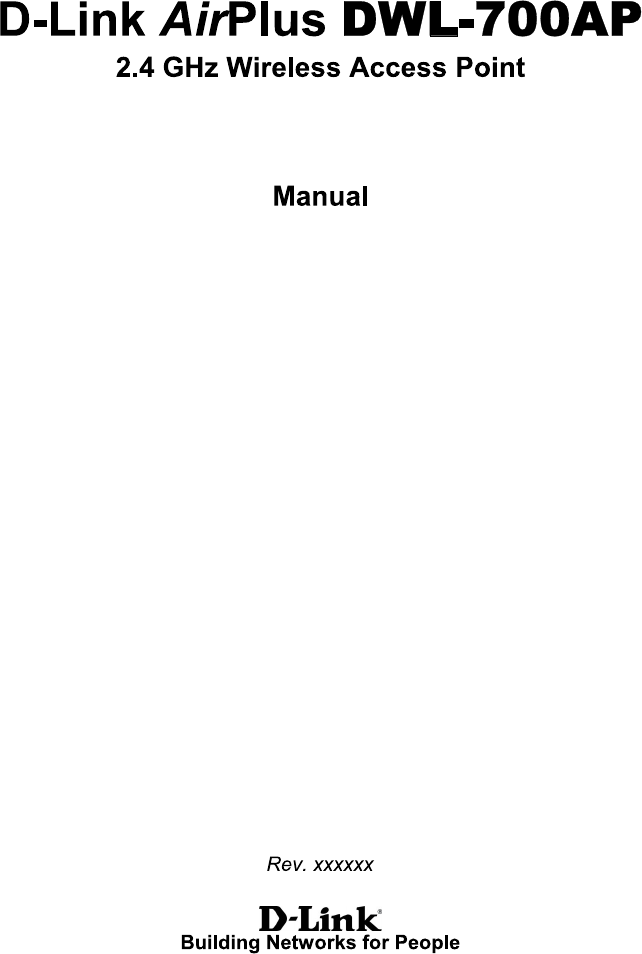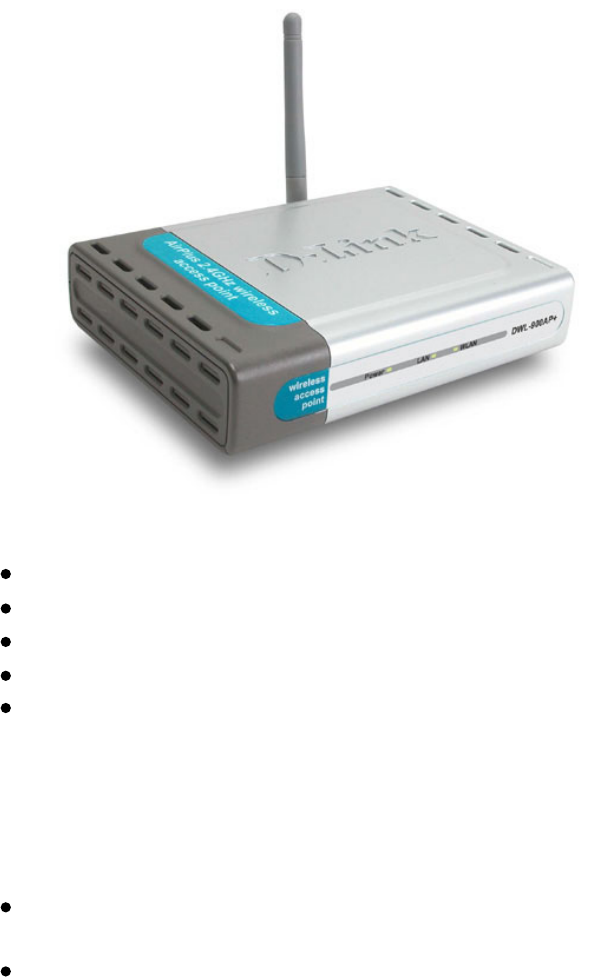D Link DWL700AP-A1 D-Link Air 2.4 GHz Wireless Access Point User Manual dwl900AP manual 224
D Link Corporation D-Link Air 2.4 GHz Wireless Access Point dwl900AP manual 224
D Link >
Contents
User Manual Part 1

1
Contents
1. Package Contents............................................. 2
2. Introduction........................................................ 3
3. Wireless Basics................................................. 6
4. Getting Started ................................................ 10
5. Using the Configuration Menu.........................13
6. Using the AirPlus AP Manager........................26
7. Troubleshooting............................................... 30
8. Networking Basics...........................................
35
9. Technical Specifications .................................. 64
10. Contacting Technical Support..........................66
11. Warranty and Registration ...............................67

1. Package Contents
Contents of Package:
D-Link AirPlus DWL-700AP 2.4GHz Wireless Access Point
Power Supply – 5V DC, 2.0A
Manual on CD
Quick Installation Guide
Ethernet Cable
Note: Using a power supply with a different voltage rating than the one included with
the DWL-700AP will cause damage and void the warranty for this product.
If any of the above items are missing, please contact your reseller.
System Requirements:
Computer with Windows, Macintosh, or Linux-based operating
system with an installed Ethernet adapter
Internet Explorer or Netscape Navigator version 4.0 or above, with
JavaScript enabled
2

3
4
2. Introduction
The D-Link AirPlus DWL-700AP Wireless Access Point is an 802.1x
wireless access point. With a second level of security that is not offered with
other conventional 802.11b standard-compatible Access Points, the DWL-
700AP ensures a more secure wireless network than ever before. In addition
to WEP encryption, the DWL-700AP offers an Authentication capability
when used with 802.1x compatible devices. This extra layer of protection will
ensure a safer and more secure wireless network than has previously been
available.
Like most 802.11b Access Points, the DWL-700AP is capable of data
transfer speeds of up to 11 Mbps when used with other D-Link AirPlus
products such as the DWL-650 Wireless Cardbus Adapter.
After completing the steps outlined in the Quick Installation Guide (included
in your package) you will have the ability to share information and resources,
such as files and printers, and enjoy the freedom that wireless networking
delivers.
The DWL-700AP is compatible with most popular operating systems,
including Macintosh, Linux and Windows, and can be integrated into a large
network. This Manual is designed to help you connect the Access Point and
the D-Link AirPlus 2.4GHz Wireless Adapters into a network in Infrastructure
mode. Please take a look at the Getting Started section in this manual to
see an example of an Infrastructure network using the DWL-700AP.
This manual provides a quick introduction to wireless technology and its
application as it relates to networking. Please take a moment to read
through this manual and get acquainted with wireless technology.
Connections
MDII RJ-45 Ethernet
Port
• Straight-Through
cable is required
when connecting to a
router or switch
• Cross-Over
cable is required to
connect to a computer
Reset Button
Power
4
Features & Benefits
• Supports 802.1x for wireless user authentication into the network,
resulting in a more secure wireless network than was previously
possible.
• With AirPlus Products - high-speed wireless data transfer rates up to
11Mbps. With this data rate and capacity, the DWL-700AP delivers
media rich content such as digital images, videos, and MP3 files as
the standard 802.11b networks
• Fully 802.11b Compatible – Fully compatible with the IEEE 802.11b
standard and interoperable with all existing 802.11b compliant
devices
• Supports 64/128-bit WEP encryption for security for your data and
wireless communication.
• Web-based interface for Managing and Configuring – Easy-to-use
interface independent of the operating system
• 4 Different Operation Modes – Capable of operating in one of four
different operation modes to meet your wireless networking
requirements: Access Point, AP-to-AP Bridging, Wireless Repeater,
and Wireless Client.

LEDS
LED stands for Light-Emitting Diode. The DWL-700AP Wireless Access
Point has 3 LEDs as shown below:
Power
LAN
WLAN
Power: solid green light indicates connection
LAN: blinking green light indicates activity; solid green light
indicates connection
WLAN: blinking green light indicates wireless activity; solid
green light indicates connection
5
6
3. Wireless Basics
D-Link AirPlus wireless products are based on industry standards to provide
easy-to-use and compatible high-speed wireless connectivity within your
home, business or public access wireless networks. Strictly adhering to the
IEEE standard, the D-Link AirPlus wireless family of products will allow you
to securely access the data you want, when and where you want it. You will
be able to enjoy the freedom that wireless networking delivers.
A wireless local area network (WLAN) is a cellular computer network that
transmits and receives data with radio signals instead of wires. Wireless
LANs are used increasingly in both home and office environments, and
public areas such as airports, coffee shops and universities. Innovative ways
to utilize WLAN technology are helping people to work and communicate
more efficiently. Increased mobility and the absence of cabling and other
fixed infrastructure have proven to be beneficial for many users.
Wireless users can use the same applications they use on a wired network.
Wireless adapter cards used on laptop and desktop systems support the
same protocols as Ethernet adapter cards.
Under many circumstances, it may be desirable for mobile network devices
to link to a conventional Ethernet LAN in order to use servers, printers or an
Internet connection supplied through the wired LAN. A Wireless Access
Point (AP) is a device used to provide this link.
People use wireless LAN technology for many different purposes:
Mobility - Productivity increases when people have access to data in any
location within the operating range of the WLAN. Management decisions
based on real-time information can significantly improve worker efficiency.
Low Implementation Costs – WLANs (Wireless Local Area Networks) are
easy to set up, manage, change and relocate. Networks that frequently
change, both physically and logically, can benefit from WLANs ease of
implementation. WLANs can operate in locations where installation of wiring
may be impractical.
Installation Speed and Simplicity - Installing a wireless LAN system can
be fast and easy and can eliminate the need to pull cable through walls and
ceilings.
7
Wireless Basics
Network Expansion - Wireless technology allows the network to go where
wires cannot go.
Reduced Cost-of-Ownership - While the initial investment required for
wireless LAN hardware might be higher than the cost of wired LAN hardware,
overall installation expenses and life-cycle costs will be significantly lower.
Long-term cost benefits are greatest in dynamic environments requiring
frequent moves, adds, and changes.
Scalability – Wireless Local Area Networks (WLANs) can be configured in a
variety of topologies to meet the needs of specific applications and
installations. Configurations are easily changed and range from peer-to-peer
networks suitable for a small number of users to full infrastructure networks
of thousands of users that allow roaming over a broad area.
D-Link AirPlus Wireless Family of LAN products include:
♦ 2.4GHz Wireless Cardbus Adapters used with laptop computers
(DWL-650)
♦ 2.4GHz Wireless PCI cards used with desktop computers (DWL-520)
♦ 2.4GHz Wireless Access Points (DWL-700AP)
♦ 2.4GHz Wireless Broadband Router (DI-604)
Standards - Based Technology
The IEEE standard-based technology assures that the D-Link AirPlus
Products are interoperable with existing compatible 2.4GHz wireless
technology. This means you will be able to transfer large files quickly or
even watch a movie in MPEG format over your network without noticeable
delays. The technology works by using multiple frequencies in the 2.4GHz
range at speeds up to 11 Mbps. D-Link AirPlus products will automatically
sense the best possible connection speed to ensure optimal network
performance.
The DWL-700AP Wireless Access Point is 802.1x compatible.
The 802.1x standard solves the problem of ensuring the safety of wireless
networks by allowing for an additional layer of security. With two levels of
8
security, Authentication and Data Encryption, the 802.1x wireless network
is more impervious to intruders than has previously been possible.
The Authentication protocol in 802.1x provides the frontline of defense
against network intrusion. EAP (Extensible Authentication Protocol) is the
protocol used for authentication. Windows XP allows you to select the type
of EAP you wish to use. All the clients, access points, and severs must share
the same type of EAP in order to communicate and ensure that the network
is secure.
If you are not using Windows XP, you can purchase EAP software to install
for the wireless clients in your network.
The second level of security in the 802.1x wireless network is WEP data
encryption. Depending on the radius server deployed in your network, you
can distribute the certificate automatically and change Encryption keys in the
wireless network. This network feature will greatly reduce the amount of time
needed to ensure secure networking by automatically changing WEP keys
periodically, thus relieving administrators of the onerous task of manually
changing keys on a multitude of workstations.
Installation Considerations
Designed to go up to 1,312 feet (400 meters) outdoors and up to 328 feet
(100 meters) indoors, D-Link’s AirPlus DWL-700AP lets you access your
network using a wireless connection from virtually anywhere. Keep in mind,
however, that the number, thickness and location of walls, ceilings or other
objects that the wireless signals must pass through may limit the range.
Typical ranges vary depending on the types of materials and background RF
(radio frequency) noise in your home or business. The key to maximizing
wireless range is to follow these basic guidelines:
1. Keep the number of walls and ceilings between the wireless Access
Point and your receiving device (e.g., the DWL-650) to a minimum -
Each wall or ceiling can reduce your D-Link AirPlus Wireless product’s
range from 3-90 feet (1-30 meters.) Position your Access Points,
Residential Gateways, and computers so that the number of walls or
ceilings is minimized.
2. Be aware of the direct line between Access Points, Residential
Gateways (routers) and computers. A wall that is 1.5 feet thick (.5
meters), at a 45-degree angle appears to be almost 3 feet (1 meter) thick.
At a 2-degree angle it looks over 42 feet (14 meters) thick! Try to make
sure that the Access Points and adapters are positioned so that the
signal will travel straight through a wall or ceiling for better reception.
3. Building Materials make a difference - A solid metal door or aluminum
studs may have a negative effect on range. Try to position Access Points,
and computers with wireless adapters so that the signal passes through
drywall or open doorways and not other materials.
4. Make sure that the device’s antenna is positioned for best reception by
using the software signal strength tools included with your product.
5. Keep your product away (at least 3-6 feet or 1-2 meters) from electrical
devices or appliances that may generate extreme RF noise.
For the average home, signal range should not be an issue. If you
experience low or no signal strength in areas of your home that you wish to
access, consider positioning the Access Point in a location directly between
the computers with wireless adapters. Additional Access Points can be
connected to provide better coverage in rooms where the signal does not
appear as strong as desired.
9

4. Getting Started
For the price of a single IP Address from your Broadband Internet Service
provider you can share the Internet with all the computers on your local
network, without sacrificing speed or security, using D-Link AirPlus
networking products.
IP ADDRESS
An Infrastructure network contains an Access Point. The Infrastructure
Network example shown on the next page contains the following D-Link
network devices:
A wireless Access Point - D-Link AirPlus DWL-700AP
An Ethernet Broadband Router - D-Link DI-604
A laptop computer with a wireless adapter - D-Link AirPlus DWL-650+
A desktop computer with a wireless adapter - D-Link AirPlus DWL-520+
A Cable modem - D-Link DCM-200
DHCP stands for Dynamic Host Configuration Protocol.
It is a protocol for assigning dynamic IP addresses “automatically.”
With a DHCP-capable gateway/router, there is
no need to manually assign an IP address.
Please note: If you have a DHCP-capable router, such as the D-
Link DI-604 or DI-614+, there is no need to assign an IP Address.
If you need to assign IP Addresses to the computers on the
network, please remember that the IP Address for each
computer must be in the same IP Address range as all the
computers in the network, and the Subnet mask must be exactly
the same for all the computers in the network.
For example: If the first computer is assigned an IP Address o
f
192.168.0.2 with a Subnet Mask of 255.255.255.0, then the second
computer can be assigned an IP Address of 192.168.0.3 with a
Subnet Mask of 255.255.255.0, etc.
IMPORTANT: If computers or other devices are assigned the
same IP Address, one or more of the devices may not be
visible on the network.
Right out of the box, with its default settings, the DWL-700AP will
automatically connect with other D-Link Air or AirPlus products.
10